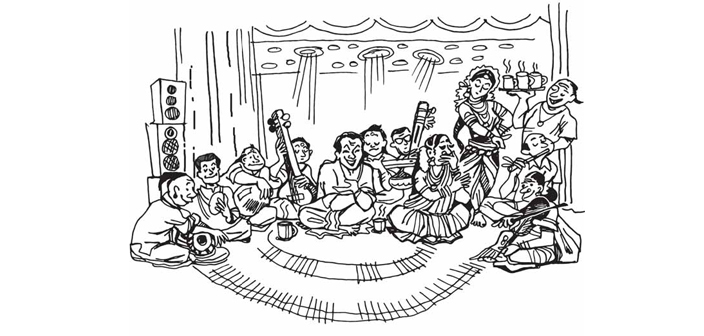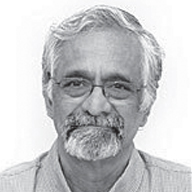It all started in 1928, when the Indian National Congress decided, when it met at Madras, to have some Carnatic music to educate and elevate the delegates. This was the genesis of the Madras Music Academy, the sage institution that confers on musicians what has come to be regarded as the highest honour in the field: the Sangita Kalanidhi. Some artistes regard this as greater than even the presidential awards from New Delhi, and many of them consider the blessings of their gurus the highest honour of all. This is one traditional value that movingly compensates for the rapid commercialisation of the arts in this part of the world, as elsewhere.
With that single act, the Congress also launched the phenomenon that the Chennai music season has come to be. It is arguably the most spectacular carnival in the world for music lovers. The sheer size and numbers of the month-long festival of Carnatic music that swamps the city during December every year have no equal anywhere, we are told by experts who have traversed the continents.
The sabha – the catalyst
The ubiquitous sabha, the uniquely indigenous institution responsible for the growth and development of south Indian classical music and dance, takes pride in showcasing the best talent available, packed into 3 or 4 concerts everyday for a period varying from 2 to 6 weeks. The honorary apex body, the Music Academy, for instance, conducts some 75 concerts from 15th to 31st December. The top ten sabhas of the city offer a similar number of programmes during the fortnight, which makes it around 750 concerts in the second half of December. Add to this, 50 other sabhas organising concerts at the rate of two a day for a month, and we get 3000 more performances during December. In actual fact, the music season nowadays begins as early as 1st November and often goes on until the end of January. The final number of concerts is a mind-boggling figure, isn’t it?
The season caters to varied tastes and budgets. The morning and early afternoon concerts are all free. In the days before sabhas proliferated geometrically, the halls at the premier venues used to be filled to overflowing for these performances by talented youngsters including child prodigies. Some 25 years ago, when a whole crop of whiz kids arrived on the block, taking Chennai’s audiences by storm, the organisers were often forced to install CCTVs in the lobbies for those who could not get in. This is how we caught our first glimpse of today’s established stars like Vijay Siva, Sanjay Subrahmanyan, Unnikrishnan, and Bombay Jayashri, a few years after the likes of E. Gayathri, Ravikiran and Sudha Ragunathan arrived on the scene. Today, the scene is different, and there are so many choices open to the itinerant rasika that full houses for these free performances are a rare sight, though the top stars featured in the ticketed concerts in the evening are paradoxically still a huge draw.
A rare exception
The festival is still run on conservative lines, despite the presence of some western instruments adapted to Carnatic music and their flamboyant practitioners. The last concert of the day, for example, invariably closes at 9.30 pm, and if the musician happens to warm up slowly and is yet to peak, so be it. He must obey the organiser’s stop watch. Though it is a complete mystery how the aberration was allowed, there was a spectacular exception in the 1960s in the form of Ravi Shankar’s concerts, which were allowed beyond midnight, with the sitar maestro and his ebullient tabla partner on stage, Ustad Allah Rakha, wishing the listeners a happy new year.
Where are the instrumentalists?
Carnatic music is perhaps one of the very few classical arts in the world practised by so many young frontline artistes. Most of the top vocalists today are in their forties if not younger, while the instrumentalists are probably even younger. Unfortunately, there are not many takers for instrumental solo concerts, even though we have quite a few brilliant exponents among us—flautists, violinists, veena and chitraveena vidwans and so on. This is in sharp, even stark, contrast to the scenario in the 1970s, when old masters like Lalgudi Jayaraman, T.N. Krishnan, N. Ramani, and M.S. Gopalakrishnan ruled the roost. Today, the best of our string and wind instrumentalists are mostly seen in accompanying roles in vocal concerts, despite efforts by small groups to resuscitate solo and duo kacheris by them.
Reality shows, NRIs and the role they play
The emergence of youngsters on the concert platform has been facilitated by a profusion of talent spotting initiatives, mainly through reality shows on television. While these probably started with the best of intentions, they have now become mindless competitions to test the skill sets of young musicians, rather than foster depth and passionate pursuit of excellence, which devoted disciples of traditional gurus in the gurukula mode of oral transmission, had to undertake to achieve eminence in their field. As a result, while we have scores of brilliant young musicians passing the most demanding tests of proficiency set by experts in the field with flying colours, they tend to fade out rather more rapidly than their seniors of a few years ago. The blame for this kind of competitiveness at the expense of depth must be shared by local as well as diasporic patrons of the arts, for clones of our reality shows have sprung up across the continents, wherever Indian music is celebrated.
This is not to take away credit from the extraordinary service NRI (Non-Resident Indian) impresarios and sabhas have been rendering in the nurturing of Carnatic music and Indian classical dance for half a century and more. Our arts owe a great debt of gratitude to our American cousins, aunts and uncles as well as Sri Lankan Tamils for their generous support. They have made music a worthwhile career to pursue and not a part time activity made secure by a well paid job. Local sabhas too have had to raise their remuneration substantially in recent years, though the artistes get paid really well mainly during the season and not through the year. Most musicians today own cars, while a scooter was their status symbol 30 years ago.
The season is made even more interesting and accessible by the number of lecture-demonstrations in the morning. The academic sessions of the Music Academy were the precursor to this growing trend, with a conscious effort by the organisers to offer programmes that explain theory and practice in rasika friendly formats. These programmes on wide-ranging topics are increasingly popular, especially among westerners and NRIs home on vacation.
This year’s season has started on a sombre note, with the passing away of mandolin wizard U. Shrinivas, and octogenarian Sangita Kalanidhi Nedunuri Krishnamurti. Shrinivas’s disciples including younger brother Rajesh, and Nedunuri’s sishyas like the Malladi Brothers, will surely pay their homage to their gurus in a fitting manner. Just as it did a decade ago, when M.S. Subbulakshmi passed away and the tsunami wrought destruction everywhere, the season will go on. It must.


